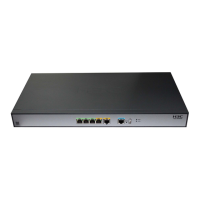12
The configuration includes operating mode (framed or unframed), framing format, CRC mode,
coding format, line idle code, and interframe filling tags.
TIP:
The Cisco E1 interfaces use the CRC4 framing format by default. The H3C E1 interfaces use
the no-CRC4 framing format by default. When interconnecting such E1 interfaces, make
sure they use the same configuration.
2. Troubleshoot the AIS alarm problems.
If the line properly transmits all-one bit streams and the idle code is FF, AIS alarms are
generated when no service data is transmitted over the line and the line transmits only all-1 idle
codes.
To resolve this issue, perform one of the following tasks:
{ Execute the undo detect-ais command on the interface to disable AIS detection.
{ Modify the interframe filling tags to 7E.
Troubleshooting the clocks
1. Select a standard clock scheme.
Depending on whether the transmission network provides a clock, an E1 interface has two
available clock schemes:
{ When the transmission network provides a clock, the transmission network provides the
master clock, and both local and peer E1 interfaces use the slave clock mode.
Figure 1 Clock scheme when the transmission network provides a clock
{ When the transmission network does not provide a clock, the transmission network
transparently transmits packets. Set the clock mode to master on one end and slave on the
other end.
Figure 2 Clock scheme when the transmission network does not provide a clock
2. Measure the frequency deviation
If the clock configuration is incorrect, frequency deviation will occur on the transmission line.
The normal frequency deviation on an E1 interface is -50ppm to +50ppm. If the frequency
deviation exceeds the range, normal packet forwarding cannot be guaranteed. The frequency
deviation will accumulate, and will continuously be bigger as time goes by. Accordingly, error
packets will appear on the E1 interface, and at last the E1 interface will become unavailable.
To restore the frequency deviation to the initial value, shut down and then bring up the interface.
Typically, you can use the ETEN meter to measure the frequency deviation of the lines.
Connect the ETEN meter to the Tx or Rx line of the E1 interface in serial, and measure the Tx
and Rx frequency deviations of the line separately.

